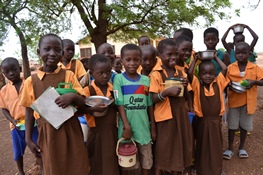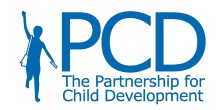 News
News  New research findings show benefits to both children and farmers of Ghana's HGSF
New research findings show benefits to both children and farmers of Ghana's HGSF
 Preliminary findings of a 3 year impact evaluation of the nutritional and agricultural benefits of the Ghana School Feeding Programme indicate that the Home Grown School Feeding (HGSF) programme in Ghana can improve educational opportunities for children especially girls and also increase agricultural incomes for smallholder farmers.
Preliminary findings of a 3 year impact evaluation of the nutritional and agricultural benefits of the Ghana School Feeding Programme indicate that the Home Grown School Feeding (HGSF) programme in Ghana can improve educational opportunities for children especially girls and also increase agricultural incomes for smallholder farmers.
|
Key findings
|
The impact evaluation was jointly funded by Dubai Cares, the Bill & Melinda Gates Foundation, the World Bank and the Government of Ghana. Designed as a randomized controlled trial, the impact evaluation focused on an innovative pilot programme implemented between 2013 and 2016 to enhance the nutritional and agricultural benefits of the GSFP. The study design built on evidence demonstrating the value school feeding has for supporting educational outcomes.
A joint research team composed of Imperial College London's Partnership for Child Development (PCD), Noguchi Memorial Institute for Medical Research, the Institute of Statistical Social and Economic Research (ISSER) and IFPRI focused on the design, data collection and preliminary analysis of the research findings, whilst the pilot implementation was carried out under the leadership of the GSFP and PCD in collaboration with other international and local partners. The study involved 116 schools in 58 districts across the 10 regions of the country. Of these schools, 58 received no intervention (control), 29 received school meals only (standard) and 29 schools school meals procured from local smallholder farmers along with MNP, deworming and health education (enhanced).
In all, the evaluation sample included over 5,500 school children and 4,500 farmers from 360 farmer-based organizations. Qualitative and quantitative data was collected for key education, health, nutrition and agriculture indicators.
The HGSF pilot implementation focused on two main components:
- The agriculture intervention aimed to facilitate stronger market linkages between smallholder farmers and the GSFP. The hypothesis behind the intervention was that this would lead to increased farmer production, sales and income and as a result improve smallholder farmer livelihoods and strengthen local economies.
- The nutrition intervention aimed to improve the education, health and nutrition of the school children through; (1) the delivery of nutritious meals by the GSFP. The quality and quantity of school meals were improved through the use of the School Meal Planner, the development of Handy Measures and the introduction of Micronutrient Powders (MNPs); (2) Behaviour Change Communication to improve nutrition, health and hygiene practices at school, household and community levels; and, (3) School-based deworming.
Preliminary Findings
The preliminary analyses focused on impact in terms of key outcomes in the education, health and agriculture domains. Data collected from children and households in the enhanced and standard schools was compared with the control schools.
Education
Enrolment levels in kindergarten increased by 12% in standard schools as compared to the control schools. Only a slight increase of 2% was noted in the case of school feeding schools for primary education, which was expected due to the almost universal education rates in primary schools of Ghana.
School absenteeism decreased by 7% in schools receiving the standard programme while no such reduction was observed in the control schools.
In addition, the analysis suggested that HGSF improved test scores in maths and literacy for girls in particular (of the order of about 10%), when compared to the GSFP. There was also impact on girl’s cognition (as measured through increased scores on visual processing tasks), with effect sizes of about 8%. This effect may be supported by the provision of the multiple micronutrient powders, which previous research has found to enhance cognitive capacity, particularly in populations with high levels of anemia. Additional analysis is underway to further investigate these effects.
Health and Nutrition
70% of children in study were diagnosed with asymptomatic malaria. More research is needed in order to investigate the impact of the supplementation on groups at particular risk of anaemia (e.g. adolescent girls). The high prevalence of malaria may have hampered the impact of the micronutrient supplementation in the pilot arm of the evaluation, as there were no differences between the traditional school feeding and the home-grown arm in terms of anaemia or the anthropometrics indicators.
Another key study outcome focused on dietary diversity – a synthetic indicator of diet quality. Preliminary evidence suggests that individual dietary diversity improved among school feeding communities, particularly amongst the younger children (5-10 years). Children receiving school feeding were more likely to consume nutritious foods like green leafy vegetables and other types of vegetables, roots, and, in the case of the 5-to-10 year olds, meat and fish.
The prevalence of worms was minimal in the study sample. This is a result of the annual deworming programme conducted in the project district and its surroundings by the Ghana Health Service. The Neglected Tropical Disease Programme was also supported by the research project.
The data analysis underway is further investigating the impact of school feeding on nutrition by teasing out the influence of selected confounders such as age, gender, health status and household characteristics. In addition, more investigation is needed into potential intrahousehold shifts in household food allocation that may have occurred in response to the school feeding intervention, as has been documented in other studies, and their implications for these preliminary findings presented here.
Agriculture
Farming activity increased by 15% in communities in the Northern Region relative to communities without school feeding. An analysis of markets in school feeding communities showed that they experienced higher produce sales and a 33% increase in the value of agricultural produce sold. Farmers in Home Grown communities experienced an increase of 5% in household income as compared to traditional GSFP. Farmers that owned a business benefitted particularly with a 10% increase in household income.
Next steps
The preliminary findings highlighted above provide a snapshot of the spectrum of outcomes assessed as part of this evaluation. The results emphasized the protective role of school feeding (and particularly HGSF) on households’ income and children’s education (particularly girls) and diets. The ongoing analysis of the rich data set from the randomized trial will provide rigorous evidence on the impact and costs of HGSF in Ghana.
More findings from the impact evaluation will be disseminated in the coming months as the data continues to be analyzed by the joint research teams at PCD, NMIMR, ISSER and IFPRI.
Further information
- Ghana Launches National School Feeding Policy
- How buckets and digital gingerbread are beating child malnutrition in Ghana



